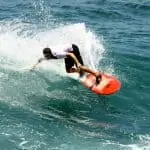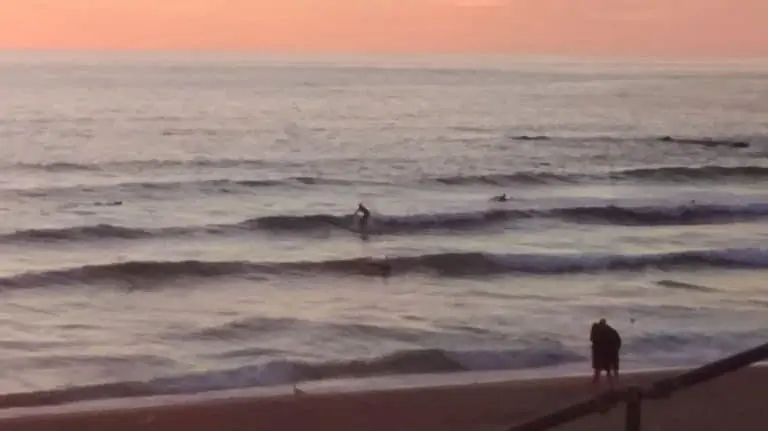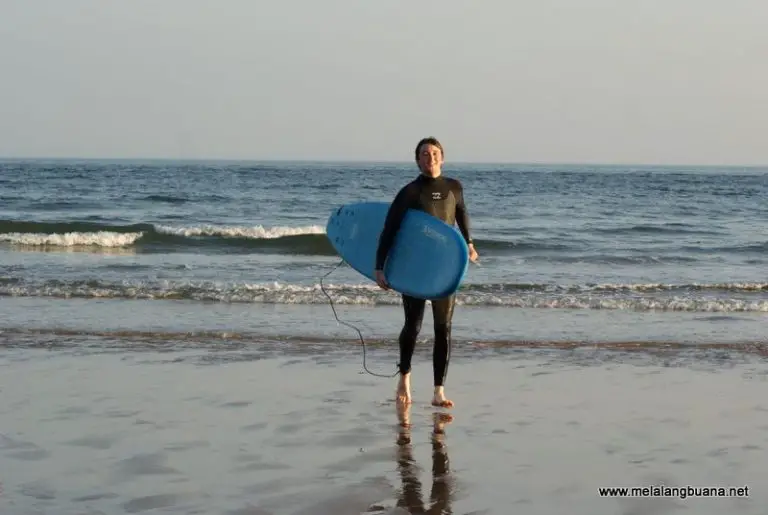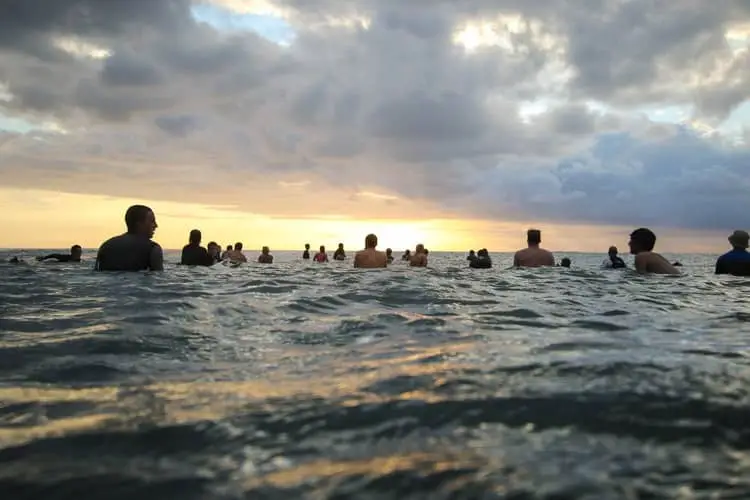Why is Surfing So Hard? (8 Reasons + How to Make it Easier)
Despite its popularity, some people are put off learning to surf because it has a reputation for being a hard sport to learn.
It’s an amazingly fun activity, but it definitely takes time to get to grips with as a learner. So, here is your answer if you’re wondering why surfing is so hard:
- Body movements like you’ve never known
- Needs a different kind of balance
- Waves move fast!
- Physically demanding
- 95% of time is not spent riding waves
- Conditions change constantly
- Every wave is a unique challenge
- Catching waves can be a dogfight
Now, that’s an overview of some of the reasons for the difficulty of learning to surf. Let’s move on to have a look at each to give you some more explanation as well as tips for how you can overcome each problem and learn to surf.
Body Movements Like You’ve Never Known
The movements needed for surfing are really different to just about any other sport or activity out there.
The 4 main movements in surfing are:
- Paddling
- Duck diving (to go under broken waves)
- The ‘pop up’
- Riding the wave
Each of these movements is a little bit different to the closest thing you will have done elsewhere, so this means it takes a while to get used to them.
Paddling
You will need to paddle on a surfboard to get out into the waves and catch one. But even this seemingly simple action is really tricky when starting out. Not only is the paddling motion different to a front stroke in swimming, the closest action, but you will also be balancing on a board in the sea with waves coming at you!
Duck Dive
To get out into position to catch waves, you will need to perform what is called a ‘duck dive’, where you push your board under a wave that is coming towards you to avoid the main impact of the wave and not get pushed backwards towards shore.
I remember having real difficulty with duck dives early on, simply because they feel so different to any movement that I’d ever done before!
Pop Up
The pop up in surfing is the movement of getting from lying on your board to standing upright. Essentially, you put your hands under your shoulders and push yourself up into a standing position.
The movement is a bit like the second half of a burpee push-up, except you will be doing it while on a moving board, in the sea and need to twist your torso to get into position!
With all this combined, it can really blow your mind trying to get it right early on, but you can definitely practice the pop up movement at home and just keep trying to get the muscle memory in place to help you along on the steep learning curve.
Riding the Wave
After you’ve done all of the above, then you have the task of riding a wave. This means pushing your legs up and down to get speed while also reading what the wave is going to do next.
Combining all of the movements at speed can be hard for learners, but the only way to practice this one is to get out in the surf and catch lots of waves – no shortcuts here!
Needs a Different Kind of Balance
Surfing balance is a really strange thing. It’s a little bit like both skateboarding and snowboarding, but then also very different because the sea never stops moving, and neither does the wave under your feet when you are riding!
As some examples of the different parts of surfing that each require their own type of balance, you will need to sit up on your board when waiting for waves, which is in itself a tricky task.
You will also need to balance while paddling, as mentioned above, as well as the other earlier points about popping up and riding a wave.

Each of these tasks is very different and again takes time to learn, especially the wave riding part as that comes last and can be extremely frustrating at first.
As far as practising for this part of surfing, balance boards can help you to prepare since they are the closest thing on land that you can do for the balance that you need.
These are basically wooden boards on a roller that you can tip back and forth to simulate something a little bit like balancing on a surfboard.
Balance boards are very popular and also a good way to pass the time staying in surf shape when you cannot get to the beach.
My helpful guide to balance boards for surfers explains everything you could want to know about these so check it out!
Waves Move Fast!
Waves are moving constantly and can appear on the horizon seemingly out of nowhere. The time between you seeing a wave and trying to get in position to catch it might only be a few seconds.
This means surfers are constantly reacting to the ocean environment around them, paddling frantically to put themselves in the right place for a wave.
If a wave looks like it is going to break too far out for a surfer to catch, then the surfer needs to try and put themselves out of harm’s way, again in a matter of a few seconds. Although breaking waves don’t have a high speed in terms of miles per hour, it’s a different story when you are out in the ocean faced with a wall of water about to collapse on you, or just steamroll right over you!
This therefore adds another layer of difficulty to surfing in that surfers don’t know exactly when waves will come, and when they do, they come fast and are extremely powerful.
The main tip here is to stay alert to your surroundings at all time and don’t spend too much time gassing with others out in the line up – keep your eyes on the horizon as you won’t have long to react when it comes!
Physically Demanding
Another thing that makes surfing quite hard is just how tiring it is. As we’ve talked about above, you need to paddle around, duck dive, pop up, stand up, ride a wave, which all require lots of physical exertion.
Surfing movements are also explosive and often performed at high speed. This needs a certain type of fitness that can make you feel short of breath quite quickly.
Sprint paddling to catch a wave is also tiring and can really get to you.
In fact, paddling on a surfboard can take your breath away in the early days since you are working really hard while also having your chest pressed on the board. This restricts your breathing just enough to add another level to the physical effort needed.
In the early days of learning to surf you may also find that just carrying a board down the beach can be quite tiring, especially on a windy day.
One of the great things about this part of surfing is that you get a great workout and almost always sleep well the night after having had a surf.
To get yourself in physical shape for surfing, try a combination of the following activities:
- Push ups
- Burpees
- Swimming at high speed
- Bodyweight squats
- Sprint training
For some different exercises, you can also check out the following surf beginner’s workout video on YouTube from the Surf Training Factory:
Doing all of the above should help you to get into better shape in advance of your next surf session.
Little Time Spent Riding
The image everyone has of surfers and surfing, is that of something balancing on a board with their legs wide apart, knees bent and hands out in front of them. In reality, the image should be of someone paddling a surfboard because that is what surfers spend about 90% of their time in the surf doing! A further 5% is probably taken up with duckdiving, while only a measly 5% would actually be spent on riding waves, and that’s if you’re doing well!
So, for a 1 hour and 40 minute surf session, you might be lucky to spend a total of 5 minutes actually riding waves.
What this tells you is just how rare it is to get up and ride on a surfboard. The little time spent per session riding then means that you get only 5% of practise time each time out.
Given how hard it is to ride a wave, the minimal amount of time you will get to actually do it means that it takes a lot longer to learn to properly surf than most people expect.
Even when you do manage to ride a wave, it feels a lot like trying to tame a bucking bronco in the early days. The ruffles on the surface of the wave, combined with the forward motion your board under your feet and your moving body make for one heck of a combination in co-ordination and balance, something that you just can’t truly replicate elsewhere.
I can tell you that, for me, with the wrong kind of board and going a couple of times a week, it took me nearly 8 months to really get up and riding on a surfboard, and even then I was still pretty shaky!
To overcome this hurdle in learning to surf, make sure you get yourself the best kind of board for a beginner, go to the right spots, go often and try to catch as many waves as you can each time out.
If you need any help, check out my thorough guide for picking the right beginner surfboard!
Every wave is a unique challenge
On top of the minimal time surfers spend riding waves, you then have to factor in that no two waves are the same.
This means that the last wave you caught will be completely different to the next one, and the next, and so on.
This constant changing of the wave in front of you, or under your feet, means that it takes a while for surfers not only to get some ‘wave sense’, where they can predict where a wave will break, but also to be able to ride different types of waves.
For learner surfers to overcome this, the best thing that they can do is to surf at many different spots and try to see how the different waves break.
Catching Waves Can Be a Dogfight!
It’s not just the balance, technique, conditions and waves that learner surfers need to go up against; it’s also the other humans out in the surf!
You’ve no doubt seen some surf spots where there are lots of people in the sea. Trouble is that they all want the same thing as you – to catch and ride the next wave that comes in!
This means that people can end up doing all kinds of ridiculous things to catch waves, simply because they want to be selfish.
Fortunately, the worst kind of behavior is seen at the more advanced spots, so this is not something beginner surfers need to worry about too much.
To get prepared for it, though, be sure to read up on the rules and etiquette around surfing and avoid causing any issues.
You can also just surf at the mellower, friendly spots and have a blast without the idiots, so choose your spots carefully for the most fun.
Conditions change constantly
Surfing obviously happens in a natural environment and, as we all know, nature never stays the same.
Waves come from wind and blow in from miles away, but the wind and weather conditions in one day can change just as much as the waves.
This means that you might be faced with a different environment every time you go surfing, ranging from the tiny little waves, to powerful rollers. The wind can really affect the waves and can turn a fun, playful surf into an absolute nightmare in a short space of time.
On top of this, surfers need to be weather experts to try and predict the right conditions for their chosen spots. Each surf spot needs its own specific conditions, and so keeping an eye on the weather fronts and changes is a must.
Tides are also a constant factor in surfing conditions. In most places, you will get 2 high and low tides each day. Surf spots might not exist at low tide, then come alive for an hour at high tide. This again means there can be lots of waiting for the right tide, and sometimes you can miss the tide by an hour or so and completely miss out on a surf, meaning one less chance to practise and learn.
Learning to surf is therefore an exercise in adapting to your surroundings. You can’t always surf in the right conditions, and sometimes you just have to paddle out even when you know it’s not going to be good. This is because you just don’t know when the next waves might be coming your way!




